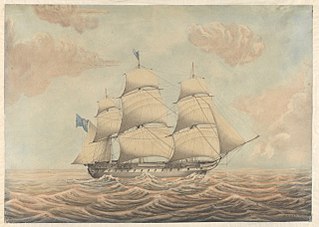Related Research Articles
Seven ships of the Royal Navy have been named HMS Africa, after the continent of Africa. Two others were planned:
Nine ships of the Royal Navy have borne the name HMS Albion after Albion, an archaic name for Great Britain:
Five ships of the Royal Navy have been named HMS Hebe, after the Greek goddess Hebe.
Nineteen ships of the Royal Navy have been named HMS Lion or HMS Lyon, after the lion, an animal traditionally associated with courage, and also used in several heraldric motifs representing England, Scotland and the British Monarchy. Another ship was planned but never completed:

HMS Apollo, the third ship of the Royal Navy to be named for the Greek god Apollo, was a 38-gun Artois-class fifth rate frigate of the Royal Navy. She served during the French Revolutionary Wars, but her career ended after just four years in service when she was wrecked on the Haak sands off the Dutch coast.
Fifteen ships of the Royal Navy have borne the name HMS Ranger
Sixteen ships of the Royal Navy have borne the name HMS Alert, while another was planned:

The Cruizer class was an 18-gun class of brig-sloops of the Royal Navy. Brig-sloops were the same as ship-sloops except for their rigging. A ship-sloop was rigged with three masts whereas a brig-sloop was rigged as a brig with only a fore mast and a main mast.
Eight ships of the Royal Navy have borne the name HMS Espiegle
HMS Stag was a 32-gun Niger-class fifth-rate frigate of the Royal Navy, and was the first Royal Navy ship to bear this name. She was ordered during the Seven Years' War, and saw service during that conflict and also during the American War of Independence.

La Réunion was a 36-gun French warship launched in 1786. During the French Revolutionary War she was stationed at Cherbourg and was successfully employed harassing British merchant shipping in the English Channel until the British captured her off the Cotentin Peninsula during the action of 20 October 1793. Renamed HMS Reunion, she served for three years in the Royal Navy helping to counter the threat from the new Batavian Navy, before she was wrecked in the Thames Estuary in December 1796.

HMS Stag was a 44-gun Seringapatam-class fifth-rate frigate built for the Royal Navy during the 1820s, one of three ships of the Andromeda sub-class.
HMS Seahorse was a 44-gun Seringapatam-class fifth-rate frigate built for the Royal Navy during the 1820s, one of three ships of the Andromeda sub-class. After completion in 1830, she was ordered to be converted into a steam-powered ship in 1845, but this did not happen for another decade.
HMS Forth was a 44-gun Seringapatam-class fifth-rate frigate built for the Royal Navy during the 1820s, one of three ships of the Andromeda sub-class. After completion in 1833, she was ordered to be converted into a steam-powered ship in 1845, but this did not happen for another decade.
Several ships of the Royal Navy have been named HMS Industry.
The Affronteur class consisted of two 16-gun luggers that Michel Colin-Olivier laid down at Dieppe in August 1794 and that he launched in 1795 for the French Navy. The two vessels took part in the Expédition d'Irlande in 1796–1797. The Royal Navy captured both vessels in 1803 in separate actions. The Royal Navy took Affronteur into service as HMS Caroline in 1804. She patrolled the Irish Sea until she was broken up in 1807. Vautour was not taken into British service.

HMS Narcissus was the lead ship of the Royal Navy Narcissus-class 32-gun fifth-rate frigate, launched in 1801. She participated in the War of 1812.
HMS Stag was a 32-gun fifth-rate frigate built for the Royal Navy. She was ordered in 1790 and work began in March 1792 at Chatham Docks. Completed in August 1794, Stag spent much of her service in home waters, where she worked to protect British shipping from French privateers. In an action on 22 August 1795, Stag engaged, and forced the surrender of, the Dutch frigate Alliante, and took part in the chase that ended with the capture of Bonne Citoyenne by HMS Phaeton on 10 March 1796.
References
- Colledge, J. J.; Warlow, Ben (2006) [1969]. Ships of the Royal Navy: The Complete Record of all Fighting Ships of the Royal Navy (Rev. ed.). London: Chatham Publishing. ISBN 978-1-86176-281-8.
- Winfield, Rif (2008). British Warships in the Age of Sail 1793–1817: Design, Construction, Careers and Fates. Seaforth Publishing. ISBN 978-1-86176-246-7.